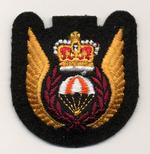Canadian Forces – Search and Rescue (SAR)

"For over fifty years the men and women of Canadian Forces Search and Rescue have met the challenge of locating and assisting Canadians in need. Their consummate skill and devotion to duty have made Canada's SAR system one of the best and most advanced in the world."
For more than seventy years, Canadian Forces Search and Rescue (SAR) personnel have been a proud part of this country's military community. Canada's SAR program is recognized as a world leader and innovator in this essential area of humanitarian service. Initially formed in 1944 as the Para-Rescue Service during W.W.II - the idea was conceived by W.R. “Wop” May, OBE, DFC. who was the civilian manager of No. 2 Air Observer School at Edmonton, Alberta.
In 1947 the Royal Canadian Air Force (RCAF) was given the responsibility for the provision of air resources to respond to air and marine incidents and in 1951, was tasked with the responsibility for the overall coordination of SAR in Canada.
Early aircraft and boats were not equipped with emergency radio beacons and search crews relied solely on visual indicators to locate those in distress. Later, with the invention and subsequent widespread use of Emergency Locator Transmitters (ELT's), search aircraft were able to conduct these searches electronically. In the early 1980's, a world wide satellite system, COSPAS-SARSAT, was developed jointly with the governments of France, Russia and the United States, which enabled search aircraft to respond more quickly and accurately to distress calls and greatly improved the chances of survival. Canadian Forces Base Trenton (8 Wing) acts as the Canadian Mission Control Centre and is Canada's link to the COSPAS-SARSAT satellite-based rescue alerting system.
SARSAT stands for Search and Rescue Satellite-Aided Tracking. COSPAS is the Russian equivalent, which stands for the search for vessels in distress'.
The military component of Canada's Search and Rescue team is made up of more than 650 Canadian Forces personnel in three classifications: aircrew, ground crew and air controllers. The aircrew include pilots, air navigators, flight engineers, loadmasters, and search and rescue technicians. The ground crew are composed of aviation, avionics and structures technicians. All Rescue Coordination Centre Air Controllers are experienced pilots and navigators.
An average of 1,500-2,000 missions are conducted annually by aircraft and personnel located at five primary SAR units: 103 Search and Rescue Squadron at Gander, Newfoundland, No. 413 Transport and Rescue Squadron at Greenwood, Nova Scotia, No. 424 Transport and Rescue Squadron at Trenton, Ontario, No. 435 Transport and Rescue Squadron at Winnipeg, Manitoba, and No. 442 Transport and Rescue Squadron at Comox, British Columbia. Missions are coordinated by three Rescue Coordination Centres (RCC's) located at Halifax, Trenton and Victoria.
Annually, more than 7,000 incidents are coordinated by the RCC's, which are jointly manned by Canadian Forces and Canadian Coast Guard SAR experienced personnel.
In addition to the professional military members, civilian volunteers make up a large portion of the SAR team. The Civi Air Search and Rescue Association (CASARA) and the Canadian Coast Guard Auxiliary (CCGA) are volunteer organizations which provide equipment and trained personnel to assist in SAR operations.
The Belt of Orion Award for Excellence was bestowed upon Canadian Forces Search and Rescue personnel, past and present, in 1998 at a ceremony held in Montreal, Quebec.
Persons who are injured or in distress need help, fast. Every hour counts if they are to survive, but they must be found first before they can be helped. In a country such as Canada with its immense distances, rugged terrain and often harsh climate, that can be difficult. The results of studies have shown that even those persons who have survived an initial accident have less than a ten percent chance of survival in winter if the rescue is delayed beyond two days. If the rescue is accomplished within eight hours, their survival rate increases dramatically to more than 50 percent. Fortunately the combination of reliable communication signals and well-trained SAR personnel has resulted in many people being saved who otherwise may have died.
